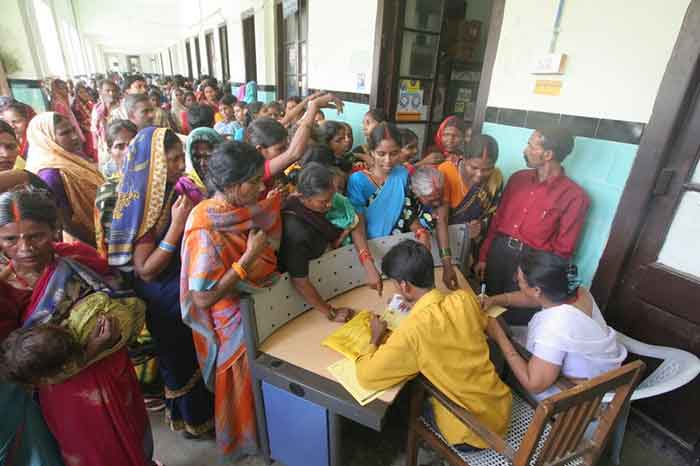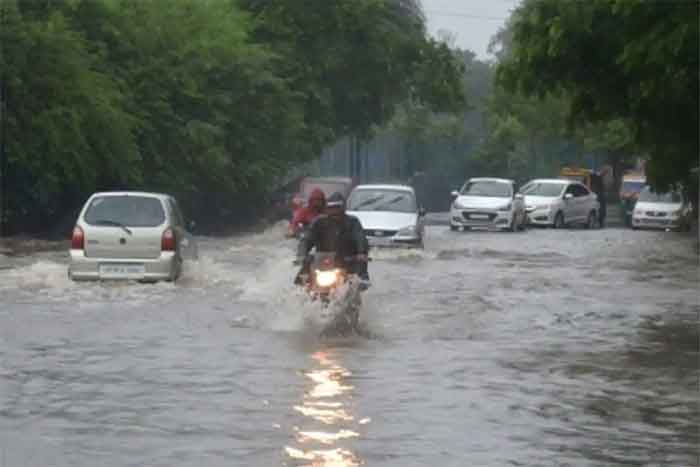
Has anything changed in the Indian healthcare system – in terms of facilities or quality of care – because of the traumatic experience of Covid over the last two years? Many would have expected such a big phenomenon as a global pandemic to make a big impact on many aspects of health policy, infrastructure and even public attitudes.
However, on the ground – as Covid Response Watch discovered – the situation of healthcare remains more or less the same as before the pandemic. The question is, why didn’t we learn from a major epidemic like Covid?
For example the Primary Health Centre (PHC) in Sangli city of Maharashtra is generally similar to that of many government hospitals in the state and the country. We visited the centre on May 4 at around 10.30 am but when we reached there not a soul was around.
When a female employee there was asked when the outpatient chamber was supposed to open, she confirmed it was 10 am as per the rules. After that, by 11.30 pm, about two dozen patients gathered there, including some elderly women. They kept peeping into the doctor’s room and asking when the doctor would come. At that time a couple arrived. When we asked where they had come from, the husband said from a village about 25-30 km away. At that moment an employee came running. We asked him about the doctor. He said that the doctor had gone to some place in another part of the district and will not be coming that day.
Another couple had come to the PHC in an auto rickshaw after leaving their work, for which they had spent 120 rupees. We can understand how they must have felt that their time and money were wasted in the absence of a doctor. So what is their fault if they go to a private hospital?
 The Indian healthcare infrastructure in rural areas has been developed as a three tier system with the Sub Centre being the most peripheral contact point with the community. It is typically meant to serve a population of around 5000 people. At the next level is the Primary Health Centre (PHC) which is a Referral Unit for 6 Sub Centres. It is supposed to have a 4-6 bedded facility manned with a Medical Officer and 14 subordinate paramedical staff. The last level is the Community Health Centre (CHC) which has a 30 bedded Hospital and serves as a Referral Unit for 4 PHCs with specialized services.
The Indian healthcare infrastructure in rural areas has been developed as a three tier system with the Sub Centre being the most peripheral contact point with the community. It is typically meant to serve a population of around 5000 people. At the next level is the Primary Health Centre (PHC) which is a Referral Unit for 6 Sub Centres. It is supposed to have a 4-6 bedded facility manned with a Medical Officer and 14 subordinate paramedical staff. The last level is the Community Health Centre (CHC) which has a 30 bedded Hospital and serves as a Referral Unit for 4 PHCs with specialized services.
The next day on May 5, we got a chance to visit another PHC in the rural area. The picture there was more frightening than the previous one. According to the guidelines of the health department of the state government, there should be one primary health centre for a population of 30,000 (in the plateau region), but this PHC was burdened with a huge population of 80,000 to 90,000. The condition of the maternity ward was very bad. However, the doctors there were seen working with enthusiasm. On the other hand, the operating room was closed for two months due to lack of water. Its building was grand. A state-of-the-art hospital-like PHC has been built at a cost of Rs.1 crore but women still go to the Sub-Centre for delivery, as the PHC does not even have a chair to sit on.
Visiting the two PHCs from the government health system makes it easy to understand why the common man is forced to go to a private hospital instead of a state-run facility for his/her treatment. However, is going to a private hospital necessarily a better option?
Many reports related to the looting of patients by private hospitals came to light during and after Covid pandemic. The question is, despite knowing that treatment in private hospitals is very expensive, why do many still prefer to go there? Should one blame the overall health system, or the people themselves?
The ‘National Rural Health Mission’, launched by the Central Government on 12 April 2005, was a good initiative that sought to reform the healthcare situation in rural India through greater investment in infrastructure. Standard guidelines were issued on what sub-centres, primary health centres, rural hospitals and district hospitals should look like.
The NRHM also saw the introduction of the Accredited Social Health Activist or ASHA workers, who are trained female community health workers in each village. Selected from the village itself and accountable to it, the ASHA is trained to work as an interface between the community and the public health system. This initiative has undoubtedly made a big difference to India’s healthcare system over the last decade and half.
There are currently a million ASHA workers around the country.
At the same time, community participation was considered important by the NRHM. It was said that the health systems would not improve unless it was operated on the basis of community participation.
In an innovative move, the NRHM set up ‘Village Health, Sanitation and Nutrition Committees’, meant to help solve health related problems at the grassroots. These committees included the village sarpanch, ASHA workers, anganwadi workers, representatives of self-help groups providing food to the Anganwadis, employment guarantee scheme coordinators, male health workers etc. at the village level. As per the original concept the committees were supposed to meet at least once a month to review public health. This information was to be given to the villagers and health officials. In addition, the Committee for Annual Planning was required to meet once a year.
Many health workers say that if these committees had worked properly in practice, the government hospitals at the village level would not have been in a bad condition to the extent they are today. Most of the committees however existed only on paper. This is a sign that the public is not aware of their own rights. If they were aware, then they would understand that no one needs to spend money out-of-pocket, or spend on illness to the extent that they spend by getting treatment in private hospitals.
While visiting villages in rural Maharashtra, huge hoardings of Shivaji Maharaj’s birth anniversary and Dr. Babasaheb Ambedkar’s birthday was seen all around. The hoardings typically are full of photographs of local youth associated with political parties or other organizations that claim to be working in public interest. One wonders whether any of them bother to visit the PHCs or Sub Centres in their areas at least once a month to inquire about its functioning or find out what the public needs in the context of health. Because if they did there is no doubt that even the government health system can work well.
Our country is a democratic country and if people do not participate in the democratic system, then naturally the bureaucracy will dominate. Even though democracy has given rights to the people, if people are not exercising them, can we always blame the system?
Shirish Khare has been associated with rural journalism for a long time and has been continuously reporting on the economic, social and health impacts of rural life during the Corona pandemic.













































